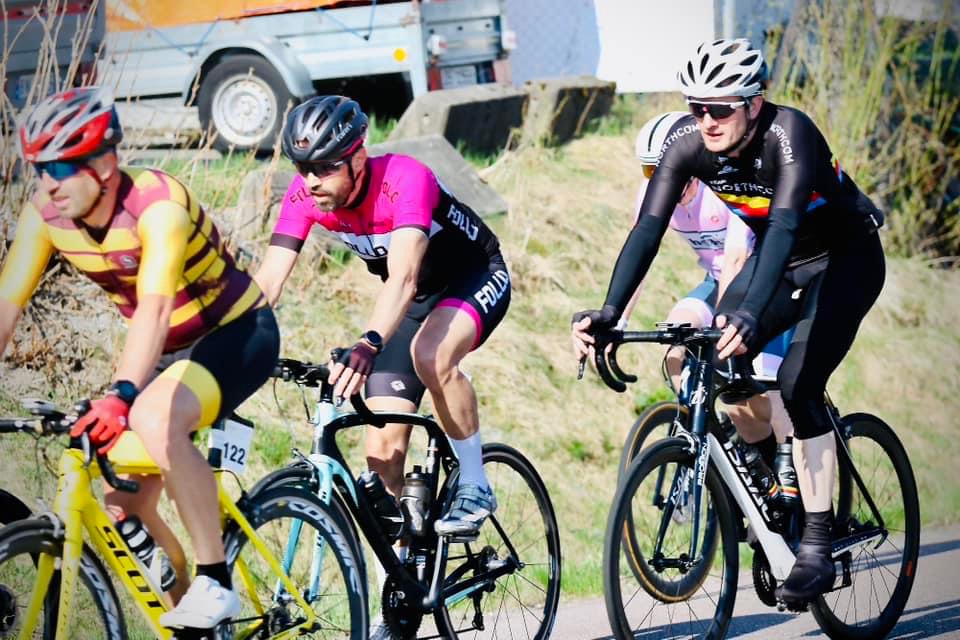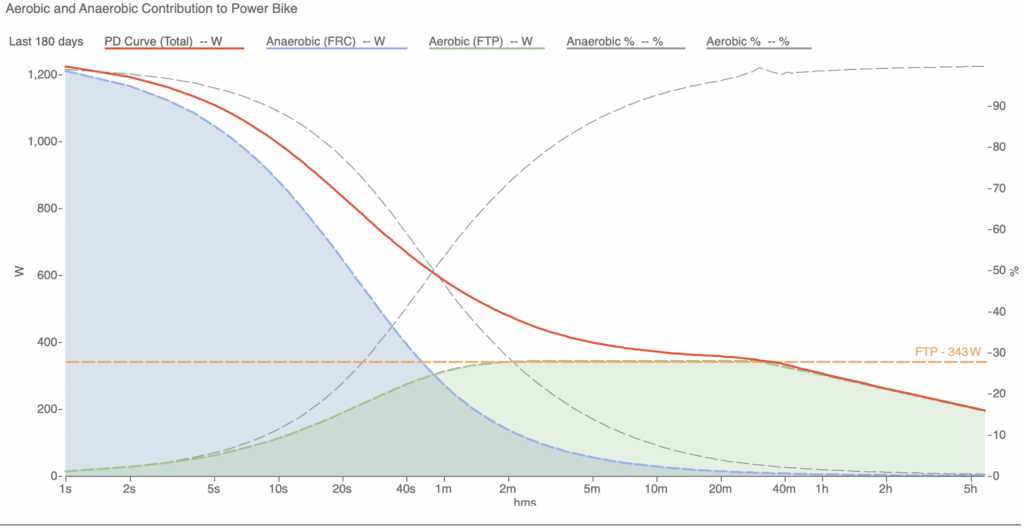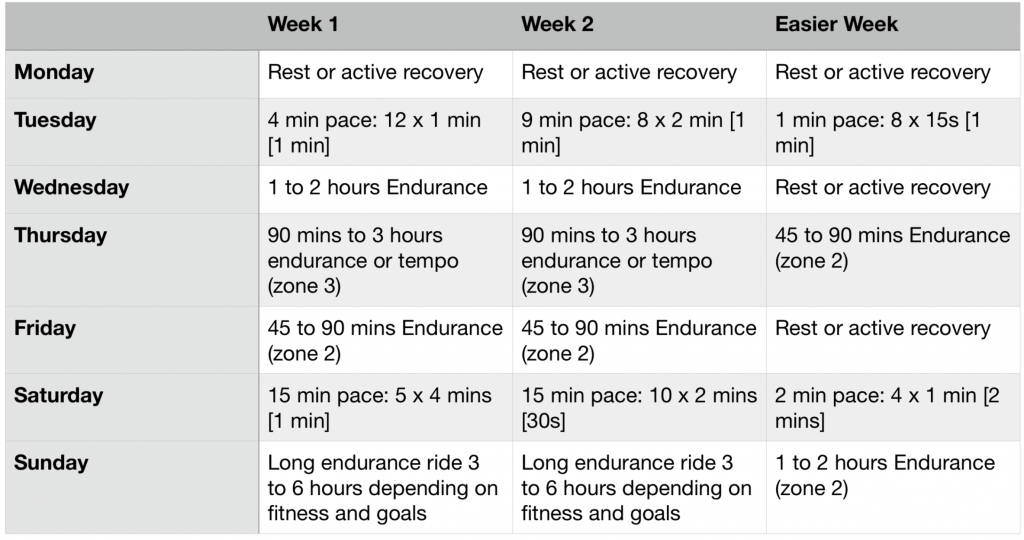Get fit for cycling using the 5 pace system

I like simple, adaptable systems and the 5 pace system is such a system. Originally, I think, attributed to the running coach Frank Horwill and attributed to the success of Sebastian Coe, who’s 800m world record stood for many years. I have successfully adapted the system to work with cycling, leading to many successes with athletes at all levels including professional elite competitors and I thought it would be useful to share the details of how to apply the system to your training.
So, what is the 5 pace system? The 5 pace system is a method of characterising higher intensity workouts that can be used in developing a structured training plan. Varying the emphasis allows the plan to address particular fitness goals. The 5 paces are your maximum 2 minute, 4 minute, 9 minute and 15 minute paces or powers and you execute training sessions at these effort levels.
When I started racing my bike, I read a lot about how to train in the most effective way and started working accordingly. I trained hard and was getting tired but I wasn’t able to complete the sessions very well and wasn’t really getting fitter. After some thought, I realised that I had a lot of experience about how to get myself fit and what had worked for me in the past as a competitive runner. I tried using running sessions in my cycling training and started improving quickly. When I started coaching, I applied the same principles to many of the cyclists (and runners) I coached, resulting in often surprising successes.
The 5 pace system
The 5 pace system was originally designed for endurance athletes, training to race on the track and cross country running events, but I have found that it is quite generally applicable with a few tweaks. The 5 paces are 400m, 800m, 1500m, 3000m and 5000m pace, which bearing in mind that the system was designed to work with elite athletes, can be roughly attributed to 1 minute, 2 minutes, 4 minutes, 9 minutes and 15 minute paces (or powers).
By using durations, we can then generalise the system to be applicable to running or cycling and to work with either pace for running or power for cycling. With these generalisations we can set applicable sessions within a structured training plan and emphasise certain training goals by adding more or fewer sessions at any given pace.
The real strength of the system is in how specific training sessions are structured to work with each pace. The 800m pace sessions were designed to include the same distance recovery as the efforts, so a session of 8 x 200m would have 200m recoveries.
Recoveries were designed to be at half the pace of the efforts, so not a walk/job but an easy endurance run. Working on the time assumptions I made to convert distances to durations, which are based on efforts at around 2:30/km (4 minute/mile) pace, recoveries should be done at 5 minutes/km (8 minutes/mile) pace. Our 8 x 200m session would therefore become 8 x 30s with 1 minute recoveries but these recoveries should be at an easy endurance pace.
You can see the resulting 5 pace system in the table.

As per the 5 pace system the efforts should be at the best power you can do for the respective durations, or at a commensurate level of effort. Effectively, what you are trying to do, is to hit the same pace/power for each of the efforts within a given session.
Physiology and energy systems
This can be related to aerobic and anaerobic energy systems by reviewing the base events as well as a quick check of modern tools like WKO5. The exact numbers vary but it is reasonable to assume that all of the 5 paces will include an anaerobic component.
Looking at the power duration curve in WKO for one of my athletes (a mountain bike racer), we can see that the 9 minute power is modelled as 8% anaerobic (92% aerobic). Other values are 1 minute 47% anaerobic (53% aerobic); 2 minutes, 29% anaerobic (71% aerobic), 4 minutes 17% anaerobic (83% aerobic) and 15 minutes 5% anaerobic (95% aerobic). The more anaerobic, shorter duration, the activity, the more this various between people but for cyclists taking part in events of 20 minutes or longer we can ignore the variation for practical purposes.

What does this mean in practical terms?
This means that all paces are predominantly aerobic but we can vary the anaerobic content of a given workout to either work on building anaerobic capacity, power at VO2max and/or power at threshold (FTP).
For example if you are taking part in events where you don’t vary your pace much, or don’t have to work above your FTP, there is little point focusing on developing your anaerobic capacity so you can focus on sessions based on your 4 minute, 9 minute and 15 minute paces to build your power at VO2max and your FTP.
However, if you are taking part in events such as road races, cyclocross, track of mountain bike cross-country races, where you have to work well above your FTP and and recover, you will want a significant element of 1 minute, 2 minute and 4 minute pace sessions in your plan. This is particularly the case as you sharpen up towards your racing season.
We can obviously look at this at a deeper level and set sessions based on charts such as the power duration curve shown in the figure. However, having a simple framework to work with helps us set repeatable sessions that are progressive and have measurable outcomes that are relatively easy to relate to performances.
This is particularly the case if you don’t have access to tools like WKO or Golden Cheetah that do this type of analysis. However, even if you do, taking the time to learn and understand the software and subsequently the large amount of data available is often met with diminishing returns that don’t provide meaningful advantages over using a simple approach.
As a professional coach, I use WKO5 to analyse and set training sessions that are consistent with athlete goals but I tend to do this with the 5 pace framework in mind. I like to have modular, repeatable methods that promote the development of a few variables to progress fitness. This helps me understand the data and make adjustments to particular sessions. This also provides a systematic way of making use of, and building on the considerable experience I have from over 45 years of involvement in endurance sport.
Applying the 5 pace system in practice
We now have a simple system that we can use to plan and focus our training.
With any training plan, it is a good idea to take some time to consider how your strengths and weaknesses relate to your goal event. Think about whether you are struggle with repeated efforts above your FTP or with sustaining your efforts at a little below FTP.
Both these issues will be helped by increasing your FTP because in the shorter, hard anaerobic efforts, raising your FTP will make the efforts less anaerobic, and for the longer duration endurance, raising your FTP will reduce the intensity associated with any given power or pace. Fortunately, all the 5 paces are predominantly aerobic and will develop your FTP, however, the 1 minute, 2 minutes and 4 minutes efforts will be more effective at improving your anaerobic capacity and ability to hit high powers. The 4 minutes and 9 minute paces will be most effective at improving your power at VO2max and the 9 minutes and 15 minutes paces will improve your FTP more specifically.
In general, you would aim to improve the intensity of the shorter sessions and the volume of the longer sessions as you approach your race season.
Example sessions would be:
Numbers in brackets are the powers of our example athlete with an FTP of 343 Watts from the graph shown earlier.

Recoveries should be at an endurance pace, so for this athlete, around 200 Watts
Note: your power-duration curve will be improving as your training progresses, so you will need to keep testing your maximum powers at the given durations and increasing the powers of the respective sessions accordingly. As a rough guide you could work out the percentages of FTP for the powers in the table to get your own target powers but testing is much better.
A weekly plan
This needs to be fitted into a weekly and longer term plan.
A good general approach for taking part in events of greater than an hour is to include all the 5 paces but only a small amount of the 1 minute pace efforts. I like to include an easier week every 3 or 4 weeks and it is during the easier week that I will include the 1 minute pace sessions.
Many people struggle to do more than 2 very hard sessions each week, so I tend to work with that and fill in the rest with endurance level sessions, perhaps including a tempo session if the athlete is able to cope with it without compromising the quality of the harder, interval sessions.
Bearing this in mind, and the fact that to a large extent the more training volume you do the better you will perform, with the caveat that you can do too much and compromise the quality of the harder sessions and in the worst case, your health.
With that proviso, look over what has worked for you in the past and if you feel that you can do a little more, build it into your plan with suitable check points and recovery periods.
A good 3 week plan that incorporates 2 build weeks and an easier week aiming at building FTP and VO2max power, which would be suitable for most people wanting to build fitness for events longer than 2 hours could be as shown in the table.

Note: you can do the endurance days as either one or two rides. Physiologically, it can be better to do two rides, so if you are using your commute for training or like to do something low intensity to start the day, that can work out well.
Conclusions
The 5 pace system provides a simple, understandable and progressive framework for any endurance based event, whether that is for track, road or cross country running as it was originally designed or for cycling, or even swimming using the ideas outlined in this article.
Following the principles described and adapting them to your own needs will almost certainly lead to gains in fitness and with consistent training, success in your goal events.
I hope you enjoyed this article and found it useful. If we can help you in any way, or you have constructive comments or ideas, please get in touch.
You can find other articles and videos that you may find useful in our blog articles on this site and on our developing YouTube channel.
Related Questions
Does it matter what cadence I ride at? In general it doesn’t matter what cadence you ride at as long as you are within a certain range. It is probably more efficient to ride with a cadence between 70 and 110 rpm but go with what is most comfortable for you. Your pedalling will improve if you practice riding with a higher cadence because it improves your skills, so it is worth practicing this. If you have a very low cadence, less than 70 rpm, you may get tired more quickly because you have to apply quite a lot of force with each pedal stroke, which is less efficient.
January 27, 2020

Comments